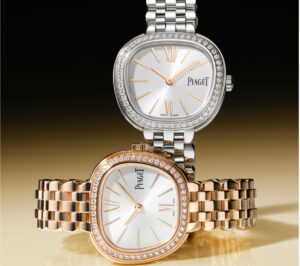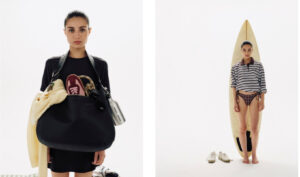In a world where interiors increasingly act as portraits of consciousness, and artworks refuse to remain simply decorative, Gilles Grimon’s Ruban Bleu commands presence—not as an ornament, but as a confrontation. Suspended above a lacquered, diamond-handled sideboard and framed by the composure of a symmetrical, white-walled salon, Ruban Bleu pulses like a digital echo through memory and emotion. It does not sit quietly. It asserts itself—a square field of disruption and precision. A mirrored self blurred by rhythm. A portrait veiled in a blue ribbon of algorithm and impulse.
This piece is not a painting. It is a conversation frozen mid-sentence—between face and pattern, digital veneer and analog soul, concealment and longing.
Grimon’s Language: Pattern as Metaphor
To understand Ruban Bleu is to understand Gilles Grimon’s design syntax—one steeped in structured abstraction, optical interplay, and encoded feeling. His artistic discipline lies not in illusion but layered tension: the relationship between the seen and the shielded, the organic and the imposed.
The work features a monochrome portrait—most likely a digitally treated photograph—rendered in high-resolution grayscale. The expression is unreadable yet piercing, made all the more intimate by its partial obscurity. Draped over this face is a seamless geometric pattern in vivid fuchsia, tessellated like a Möbius loop of perception. The pattern is not a background; it is a veil, a second skin through which the original subject must emerge—or disappear.
This overlay speaks to control, to rhythm, to the latticework of identity systems. The eye is caught in the push-pull of recognizing a face while being pushed back by its interference. In Grimon’s vocabulary, this isn’t aesthetic noise. It is symbolic static—a grid of society, surveillance, structure, rules.
The Cyan Interruption: Ribbon as Gesture
Breaking through this digital tapestry is the signature of the piece: a cyan brushstroke, winding across the portrait like an unfinished calligraphic mark. This is the titular ruban bleu—not merely a ribbon as motif, but a gesture of defiance.
Its stroke is loose, fluid, and distinctly analog. It bleeds softness through the strict geometry. It resembles both a ribbon and a ribbon’s undoing—a silken thread being pulled from the machine. Emotion infiltrating discipline. Human intuition overriding systematic repetition.
This blue is not passive. It is an electric breath. A shape that simultaneously reveals and distorts. The cyan does not highlight the portrait—it disturbs it. It says: this person is not for full display. They are encoded, archived, and yet breathing underneath.
Ruban Bleu: Ribbon as Identity, as Conflict
Grimon’s choice of title—Ruban Bleu—works on multiple levels. Historically, the “blue ribbon” signifies excellence, privilege, and victory. In naval contexts, it recalls the Blue Riband, awarded for the fastest transatlantic voyage. In fashion, it recalls the satin elegance of trim and ceremony. But in Grimon’s hands, the ribbon becomes more abstract—a symbol of entanglement, an act of concealment and tethering.
There is something autobiographical in the work’s language. Grimon, known for merging digital tools with hand-drawn disruption, creates works that feel both calculated and personal. Ruban Bleu stands as a visual paradox: a calculated grid attempting to contain a portrait that resists submission. The cyan becomes a cry, an exhale, a refusal to be quantified.
The Portrait: Real or Refracted?
Is the face known? Is it a muse, a model, a reflection? That is the enigma Ruban Bleu offers.
Rendered in meticulous grayscale and shadow, the portrait carries both timeless beauty and digital sterility. It is intimate but anonymized. Eyes wide but muted. It recalls the black-and-white muses of Peter Lindbergh or Helmut Newton, but filtered through the data-driven gridwork of Rafael Rozendaal.
Here, the face is both emotional anchor and atmospheric terrain. We see not just the person, but the layered process of trying to see. The portrait is not the subject—it is the medium through which the pattern and brushstroke collide.
Interior Context: Aesthetic Harmony with Friction
Framed within an elegant, contemporary living space, Ruban Bleu offers a case study in curated disruption. The room—minimalist, symmetrical, intentionally balanced—is disrupted by the work’s color palette and intensity. This contrast is not accidental. It is a dialogue between order and emotion.
The sideboard beneath is a muted ivory, with clean diamond accents. Brass and black framing offer a stable anchor. The rug is desaturated, the accessories minimal. In this silence, the painting becomes a voice. Or a song. Or a memory mid-forming.
Its scale—nearly the width of the sideboard—establishes it as the heartbeat of the room. It challenges stillness with its movement, clarity with abstraction. The cyan arcs create visual flow, while the pink geometry pulses with optical vibration. Together, they create a sort of visual metronome, pulling the eye into a loop of recognition and uncertainty.
Speculative Materiality and Technique
While the specifics of the material remain unseen, one can speculate that Ruban Bleu is a mixed-media digital print on canvas, possibly enhanced by hand-applied acrylic or UV-cured ink. The precision of the pattern and the tonal subtlety of the portrait suggest high-resolution digital layering, while the cyan brushstroke appears too spontaneous to be fully synthetic.
This juxtaposition—machine and hand—is a hallmark of Grimon’s known methodology. It allows the piece to exist simultaneously as artifact and interface, where layers are felt as much as seen.
Cultural Subtext: Masking and Modern Perception
There is a cultural undercurrent in Ruban Bleu—one tied to surveillance, identity politics, and emotional privacy. In a digital world where faces are scanned, filtered, and monetized, Grimon’s work feels like a pushback. It suggests that what we see is never the whole truth—that identity is processed, not just presented.
The geometric veil may represent the grid of social algorithms or the aesthetic of machine logic. The brushstroke might then be the human error, the emotional glitch that reminds us we are not data points. The portrait is the in-between space—a person caught in the act of being decoded.
Artistic Legacy and Future Echoes
Ruban Bleu is not an endpoint. It is part of Grimon’s ongoing interrogation of identity in the visual age. As he continues to experiment with layers, rhythm, and refusal, this work will likely stand as a turning point—his boldest blend yet of optical theory and emotional metaphor.
It may not offer answers. It doesn’t intend to. Rather, it invites us into an ongoing exploration of what it means to be visible, masked, read, and rewritten. In a world trained to scroll, this painting asks us to pause. To really look. And to ask: What do we actually see? What have we already been trained to ignore?
Flow
Ruban Bleu is not loud. It vibrates.
It does not scream to be understood—it waits to be witnessed. It’s a visual letter sealed with rhythm. A mirror wrapped in encryption. A portrait of resistance and release.
As Grimon’s work evolves, we recognize in Ruban Bleu the core of his practice: the collision of beauty and burden, of the graphic and the intimate. A place where ribbons don’t just tie—they unbind. Where the grid becomes a stage. Where faces, even when patterned, still stare back.
No comments yet.







